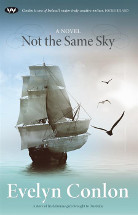Not the same sky by Evelyn Conlon

On cover: a story of Irish famine girls
brought to Australia. Wakefield Press, 2016. ISBN
9781743052426
(Age: 12+) Recommended. Migration, Irish Famine, Indentured labour,
Ship life. This book follows a group of four girls amongst a group
of Irish orphans, made destitute by the Irish Famine, who came to
Australia on The Thomas Arbuthnot, in 1849. They were under
the care of Surgeon Superintendent Charles Strutt whose diaries
about his voyage are now kept at La Trobe University in Melbourne.
In part, these diaries form the basis of the story around these
girls' lives. On board ship, Strutt made sure the girls were kept
busy with quite a rigorous regime. Rosters were organised for wash
days, singing and dancing, sewing and lessons organised so that the
girls would have a knowledge of English, more useful than the Gaelic
they spoke. They were organised into messes of eight girls each
responsible for their own utensils with each having a planned menu,
ensuring the girls had a reasonable diet aboard ship. Matrons
appointed to look after the girls made sure the deck where the girls
lived were scrubbed and kept clean, minimising disease.
Strutt thought about all the problems he was likely to encounter,
and set out plans to circumvent these. He made sure the girls, all
from different backgrounds, got on well, and were kept away from the
crew, and that he and the captain were on cordial relations.
On their arrival in Sydney they were housed in the Barracks, and
then allotted families where they would work as servants, some in
rural towns, as well as Sydney. Strutt stayed and supervised the
girls and their appointments, actually traveling to Yass with one of
the groups. He did keep in touch with some and through his visits we
hear of what happened to some of these girls, as they found husbands
and had children. One of the girls whose lives we follow in this
recreation takes on a life on the stage.
Historical fiction makes fascinating reading, as we see into the
lives of the girls, based on diaries and historical research. The
prologue introduces Joy Kennedy a monumental mason in Ireland who is
contacted to build a memorial to these women and her story gives a
modern day moral perspective on what happened to them. Life on board
the ship was for me the most interesting part of the tale, and
Strutt's care and attention to the daily routine of the girls
admirable.
For readers interested in a small part of Australia's immigration
history then this is a most interesting read.
Fran Knight